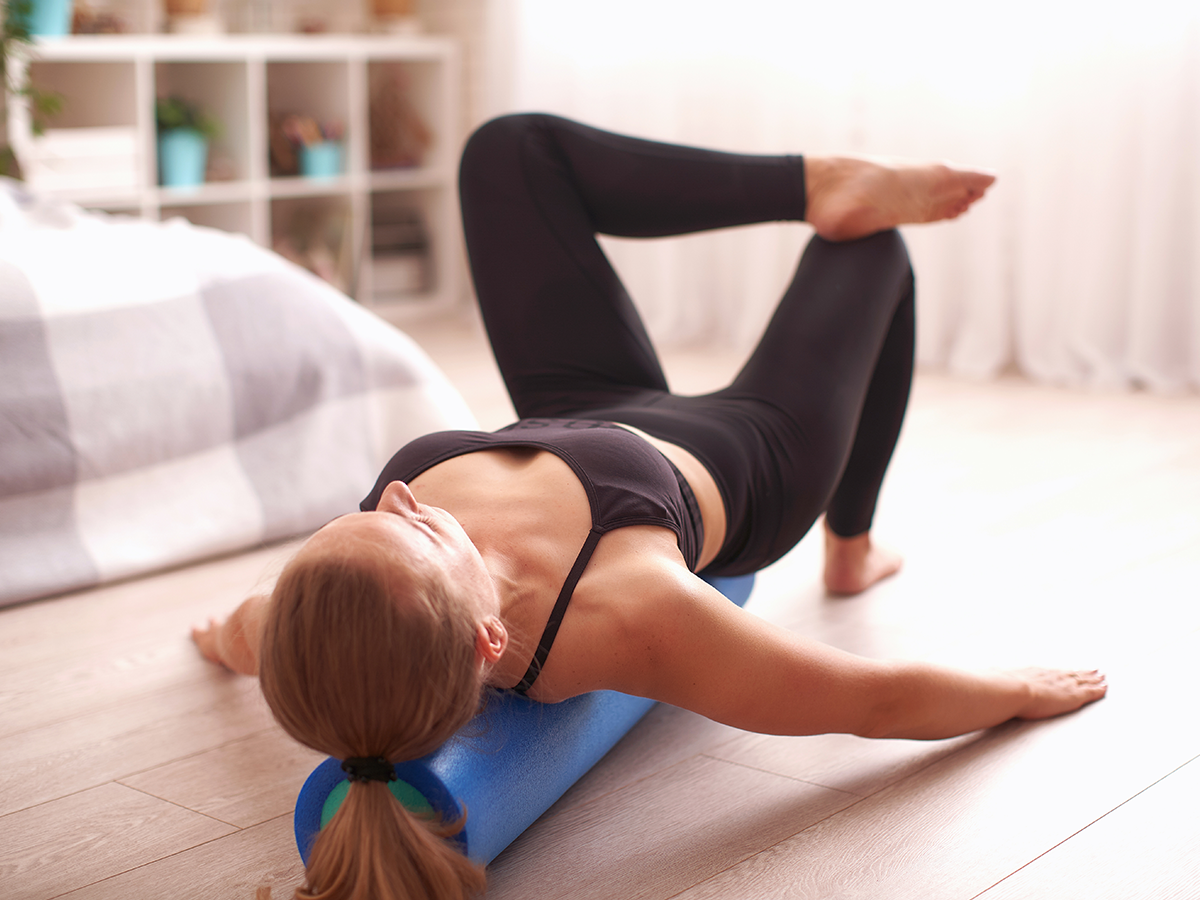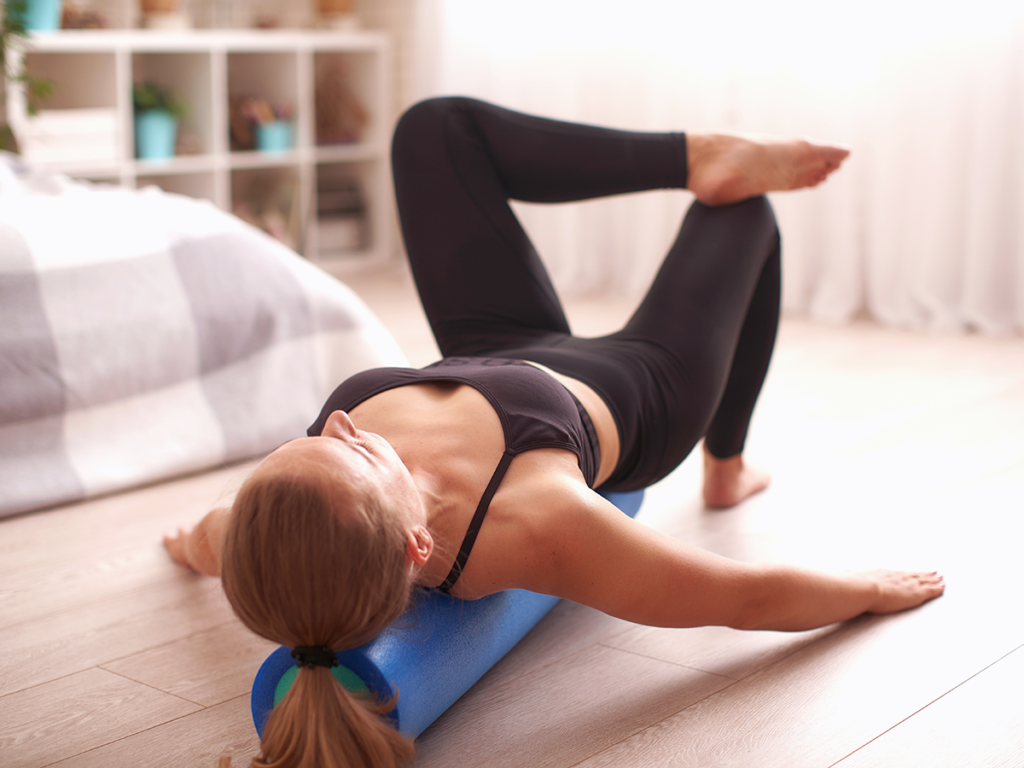

In our latest article, we look at the the benefits of foam rolling and talk you through a simple at-home foam rolling routine that you can incorporate into your day to optimise your health.
With many of our states rapidly moving in and out of lockdown, our usual gym and exercise routines have been turned on their heads. Many of us have switched to home-based exercise – and this is where that foam roller that we’ve had sitting at home that perhaps hasn’t had too much use can now go a long way. From helping sore muscles to improving our flexibility and optimising the way we move to help prevent injury, foam rollers are powerful tools. Given their affordability, accessibility and ease of use, we love them as physios.
If you’re new to foam rolling or need a refresher, we’ve put together five simple foam rolling exercises that you can do at home today to optimise your exercise – and your wellbeing.
A Few Tips Before You Start
To help get the most out of your foam rolling and stay safe, remember:
- Foam rolling can feel uncomfortable and somewhat sore when you’re applying pressure directly to tight tissues. If your foam rolling is feeling extremely painful, or you feel like something isn’t right, either stop immediately, or adjust the pressure by better supporting your body so that all your body weight isn’t directly on the roller.
- Roll slowly and with control. It’s not about how many ‘reps’ you do or getting them ‘over and done with’, but the benefits come from how you perform each roll. Move over your foam roller slowly and carefully, no more than 2-3cm per second.
- You’ll likely have areas that feel pretty sore and tight. Take your time with these, moving slowly over these points back and forth, until the initial pain you felt eases somewhat, though ideally not longer than 20-30 seconds per tender area. Remember that if it’s too sore, stop or adjust the pressure.
- Don’t roll directly over a joint or bone – the foam should be working on the muscles
- Don’t roll around an injured area unless your physio has explicitly cleared you to do so
- Don’t use a foam roller for your neck – there are too many variables, and too much can go wrong. Necks are sensitive areas, so always see your physio if you’re experiencing neck pain or discomfort.
- It’s not a competition to test your pain threshold. Listen to your body, and don’t place excess pressure on an area for too long.
The 5-Step Routine
1. Rolling Your Calves
Rolling your calf muscles focuses on working that big muscle belly at the back of your lower legs that contains your gastrocnemius and soleus. These play important roles in helping lift your heel off the ground.
Sit on the floor with your legs extended in front of you. If you’re rolling your left leg, bend your right knee and place your foot on the ground – this will be used to help support your body and control the pressure. Placing your hands behind you, place the foam roller beneath your left calf in the thickest part of the muscle. Lift your hips so your body is now slightly elevated and you feel the pressure where your calf is resting on the foam roller. Slowly roll backwards and forwards, using that right leg for support and stability, for up to 60 seconds. Linger longer on any tender areas. Do not roll over your Achilles tendon or your knee joint.
2. Rolling Your Quads
Rolling your quads focuses on the muscles at the front of the thighs. These muscles help you straighten your knee – including helping you stand from sitting and keeping you supported while you’re standing.
Start in a plank position and place the roller beneath the middle of the thighs. Here you can control the pressure and intensity by helping raise your body with your feet and forearms. Roll back and forth slowly, lingering on the tender areas as above. To increase the intensity, roll only one leg at a time, crossing the other leg up behind it. As the quads are quite large, you can alternate the angles as you roll, so you roll both the middle and outer areas of muscle.
3. Rolling Your Glutes & Piriformis
Your glutes support the healthy function of your hips – from helping extend the hip, to helping you raise a leg up to the side, to stabilising your pelvis and supporting the lower back.
Sitting on top of the foam roller with your hands on the floor behind you and your legs bent out in front, bend one leg up and across so that the ankle is resting on the opposite thigh or knee. Lean in towards the raised side so that the glute is in contact with the foam roller. Roll slowly backwards and forwards for up to 60 seconds, lingering on any tender spots.
4. Rolling Your Lats
Your lats are your latissimus dorsi, a pair of triangular muscles in the back that play a big role in moving your shoulder. While this isn’t the most comfortable roll, it’s often forgotten and can have great benefits in managing shoulder pain.
Lie down on the left side of your body with your left arm extended above you, resting on your forearm. Place the foam roller below the side of your rib cage, at about your mid-torso. Keep your left leg straight and flat on the ground, and bend your right knee in front of the left to help with support and stability – or place it however you feel comfortable. Slowly roll up towards your armpit while straightening your arm, then back towards the rib cage. Do this for up to 60 seconds, lingering on any tender spots.
5. Rolling Your Thoracic Spine (Upper Back)
Your thoracic spine, located in the upper back region, helps to keep your lower back and shoulders moving well and without pain. Studies have shown that you have less chance of lower back pain, neck pain, and shoulder pain when you have a mobile and unrestricted thoracic spine.
Sit on the floor, placing the foam roller behind your upper back. Cross your arms in front of your chest, keeping them just below the armpit. Keeping your knees bent out in front of you for support and stability, lift your hips off the flow and slowly roll backwards and forwards for up to 60 seconds. Avoid rolling into your lower back or neck.
Getting The Right Exercise & Rehab Program For You
While these foam rolling exercises are a great start, they don’t account for any injuries, problems, weaknesses or other unique circumstances you may have. We always recommend getting your exercise prescription from your Physiotherapist – your comprehensive exercise program will offer alternative techniques and other specific exercises that work best for your body and circumstances.
If you want to maximise your home workout, your local Allsports Physio team is here to help. Book in online here or call the clinic near you.
